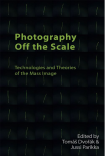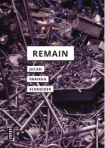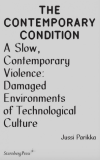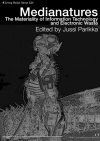Archive
Japanese translation of A Geology of Media
I am happy to see this out: the Japanese edition of A Geology of Media. A big thanks to Yoshitaka Ota and the publisher for their work in making this happen. See here for more info – and if you do not read Japanese, check out at least the gorgeous cover design (that features a detail from Danish artist Honey Biba Beckerlee’s work). For the first brief review of the book in Japanese, see here.

Antikythera
The new Antikythera program headed by Benjamin Bratton launches, and I am happy to be involved as affiliated faculty.
It is a “program reorienting planetary computation as a philosophical, technological, and geopolitical force” and you can check out the website for details as well as how to apply. The selected studio participants (Los Angeles) will be fully supported with a housing provision and a monthly stipend of 4000 USD per month. The program also covers the additional research and field trips.
New Czech titles
Now published in Czech, two closely connected books: the translation of What is Media Archaeology? (transl. Michal Šimůnek) and Martin Charvát’s book about my work Jussi Parikka: Od archeologie ke geologii médií (“Jussi Parikka: From Media Archaeology to Geology of Media”). Very excited and grateful to both of them for their work, insights, and careful attention.

The publisher is NAMU press.
Below a short glimpse of the interview we did with Martin for his book (note that the original English discussion has not been tidied so please excuse any minor language hiccups).
<M. C. As I see it, in your work there is a strong tendency present: from the analysis of „dark sides“ of digital culture to geology of media, to the (on the one hand) abstract but strictly material frameworks (or empirical conditions of possibilities) of contemporary digital culture based on using (in a sense of dependency) material from Earth, and to the (on the other hand) urgent need to look at these phenomena through (to put it in Deleuzean terms) “geology of morals”, which transcends a priori critique of technique, and thematizes the usage or cultural techniques emerging in contemporary society and connect them with geo-political climate.
J. P. I was originally trained in Cultural History (in Turku, Finland) which was great background education to consider the broader historical contexts of contemporary culture. It was also a context where I had to do extra work in figuring out how I can continue my theoretical interests while engaging in historical methods. One line of thought that cuts across those themes, those tendencies, is that I am interested in the anomalous, whether that is in relation to the dark sides and accidents of technological culture or in terms of the alternative methodological and conceptual angles that unfold a different perspective. The Deleuzean impact was early on really important for me – I still remember well the course on Deleuze (and a bit on Guattari) that professor Jukka Sihvonen gave in Turku and that I attended together with my friend, media scholar Pasi Väliaho. It was an eye-opener. I did not know how to place it exactly in terms of my other studies but it crept into some work I did in Finnish (including a book that was published in Finnish, Koneoppi) and then to some themes in Digital Contagions that was also my doctoral project that later turned into a book. Another influence was Friedrich Kittler, also introduced by Sihvonen, and whose work then became a different way of trying to start thinking questions of materiality which led into discussions also in new materialism from a much more material feminist position. Rosi Braidotti’s seminars in 2005 were another eye opener.
But in terms of the theme of the anomalous – it does not necessarily mean even marginal. Just that from Digital Contagions to later work, I was trying to come up with questions that are not necessarily at first obvious; conceptual twists that offer different perspectives while building on existing theoretical and scholarly traditions, but also rhetorically are able to frame a different way of understanding those conceptual entities inside “media studies” but also way outside it.
The geopolitical that includes Earth energies is far from marginal but I felt a necessary way to continue the link between conceptual work, extended media studies perspectives, and burning contemporary topics. I was trying to avoid it being merely a contribution to the Anthropocene debate about this new geological period defined by industrialism, synthetic chemistry and massive scale of agriculture, the nuclear age and mass exterminations of multiple kinds – including as many have pointed out, colonial time scales – and think of ways how the question of materiality can be placed in questions of ecology. Geology of morals turns into a Robert Smithson inspired large-scale, landscape-scale changes impacted by media and technological culture that also challenges models of agency and definitely forces non-anthropocentric perspectives both in analysis and in coming up with ethical solutions. To riff with Braidotti’s ideas: it was the ideal of the human in the modern Western humanism that got us into a lot of trouble with its colonial human (able-male) centric ways of organizing worldviews; now we are in the midst of a larger transformation where other questions have to be brought forward for a more radical sustainable future.
[…]
M. C. Currently you are the head of GAČR EXPRO project at Prague Famu. Could you elaborate please a little bit about the topic of the research? (Operational images)
J. P. Operational images is a concept that stems from the filmmaker Harun Farocki’s work and investigations. Already in his work in the 1980s and 1990s he mapped visual forms of measurement and rationalization of the world in relation to political history, violence, holocaust, and industrial scale violence although the concept emerges in a more articulated form in the Eye/Machine video series of installations between 2000-2003. While Farocki’s work is interesting as such – in how it articulates themes of proximity/distance, visuality/calculation, war/media – our project picks up on the concept itself: operational images as images that function primarily as part of a (technical) operation like in the case of self-guided missile systems, machine vision systems, robotics, etc. The concept has had a vivid afterlife following Farocki and it pops up in use by theorists and artists such as Hito Steyerl and Trevor Paglen, as well as in works by many of the colleagues in media studies etc., but we are interested both in how to use it as a concept to outline alternative histories of photography and visual culture and to open up new questions in contemporary contexts of art and visual theory.
For example, I am working with Abelardo Gil-Fournier on outlining questions of vegetal materiality and visual culture, from late 19th century plant physiology and framing of photosynthesis to broader scales such as in Vladimir Vernadsky’s take on the planetary biosphere. We are interested in how from questions of photography and visual culture we can outline a take on operational images in scientific contexts, planetary scales of plants and agriculture, and this refurbishing of the planet by way of terraforming that has taken place for example indeed in agriculture.
Of course the project incorporates more than that. Tomas Dvorak’s investigations into photography as measurement is one insightful way of dealing with the overlap between methods in history of science and media; previously, our conference theme was on Expert-Readable Images expanding the idea of machinic agency of images (Machine-Readable) to the work of experts and specialist practices too. Also our book Photography off the Scale that came out in 2021 with Edinburgh University Press included contributions from our project team on the question of measure, scale, and quantity in photographic culture.
The book Operational Images. From the Visual to the Invisual is forthcoming from University of Minnesota Press in 2023.
Trois essais sur l’écologie des media – translations in French and Spanish
Two new translations of my work came out from the printers just before the winter holidays. Two collections consisting of three essays of mine are published in French (T&P Publishing, Paris) and Spanish (Mimesis, Chile) with both of the editions complemented by a new preface by Peter Szendy. A brief quote from Szendy’s wonderful text (in the French edition):
“Les miettes, les rognures, les déjections qui restent et que ces trois textes cherchent à penser ne sont pas à strictement parler les résidus d’un repas, c’est-à-dire d’une ingestion et d’une digestion organique. Les commensaux qui, dans ces pages, consomment et jettent ou rejettent ne sont pas des vivants humains ou animaux : ni mammifères, oiseaux ou insectes, ni même bactéries ou virus (quoique le virus et l’insecte soient ailleurs l’objet des réflexions de Jussi Parikka, par exemple quand il s’intéresse à la généalogie du modèle de l’essaim en informatique ou à l’idée selon laquelle les contagions virales qui se répandent dans le monde numérique relèveraient d’un métabolisme ). Ici, les commensaux du grand festin dont L’Anthrobscène ramasse et analyse les restes, ce sont les médias eux-mêmes.”


More information on both of the new editions:
L’anthrobscène et autres violences – translated by Agnès Villette).
Grounding
Our video piece Seed, Image, Ground is on display until October 18 at the Grounding exhibition in St Petersburg, at the Dokuchaev Soil Museum. For us, that institutional and narrative context is perfect, considering the book on Vegetal Images we are writing with Abelardo Gil-Fournier features occasional appearances of Dokuchaev, Vernadsky, and others.
Furthermore, the video is featured currently in an exhibition on air/atmosphere in Shenzen, in this one on soil/grounding in St. Petersburg, and next year in a context that adds another elemental twist to the contextualization of Seed, Image, Ground (that was originally commissioned by Fotomuseum Winterthur for their series “Strike/Situations”.)

Lost Islands
Lost Islands, a performance project by Samir Bhowmik (and co-choreography by Esete Sutinen) is on now at the Helsinki Biennial. Book your place if in Helsinki, but have a look at the trailer video for a glimpse of the themes: anthropocene, infrastructure, architecture, etc.
“Lost Islands is a series of expeditions tracing the route of an imaginary subterranean and underwater cable through the island of Vallisaari, with the artist serving as tour guide and narrator. The expeditions venture into the island’s topography, forested pathways, waterways, historical buildings, ruins and bunkers. Along the way, visitors are engaged and immersed in installations, film, theatre, contemporary dance, song, and experimental music. The expeditions will take place as a series of events staged on the island from June to August.”
For more info on the work and credits, see also https://helsinkibiennaali.fi/en/artist/samir-bhowmik/ .
Strelka podcast interview
Posting this earlier (Feb 2020) recorded interview at Strelka institute, Moscow; Geology of Media is a starting point but the discussion ends up in many other areas as well.
“What kind of cultural theory would be adequate for the age of climate disturbances, technological shifts, and large-scale infrastructures? In this episode, Jussi Parikka, a media theorist and author of ‘Geology of Media’, talks about the materiality of media, slow environmental violence, and the way to apply his theory to The Terraforming. Design research program The Terraforming is a three-year (2020–2022) initiative of the Strelka Institute, directed by Benjamin H. Bratton.”
Instrucciones para sortear el apocalipsis – a new interview in Spanish
A new interview with me came out in the Argentinian newspaper Perfil on the occasion of the new translation (publisher: Caja Negra). The article also includes this fabulous visualisation that must be one of the best ones of me ever.

Una geología de los medios
I am happy to learn that the Spanish translation of A Geology of Media is now out and available! Una geología de los medios is published by the Argentinian publishing house Caja Negra. A big thanks to the translator, Maximiliano Gonnet, professor Claudia Kozak for writing a preface to the new edition, and the whole team that made this version possible. The Spanish edition also includes a bit of extra: an interview conducted by Alejandro Limpo, titled “Una teoría vertical de los medios” – a vertical theory of media – where we discuss some of the broader contexts of A Geology of Media as it relates to contemporary themes of materiality, environmental humanities, and more.
CCCB (Barcelona) published a preview of the Spanish translation (as well as Catalan excerpt!) – some of the joint work we did with Garnet Hertz on “zombie media”.





















